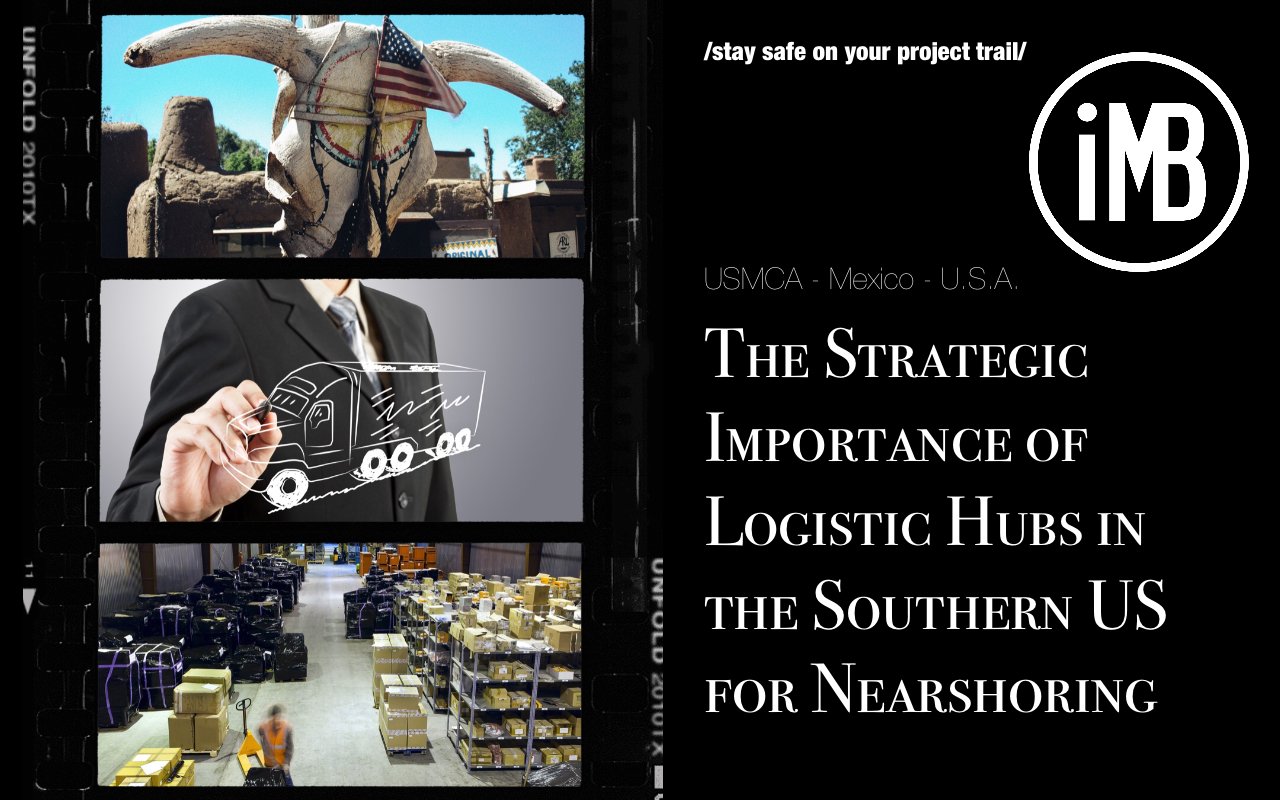Nov. 6th, 2024 - Zero Dark Thirty - A New Business Model for SMEs is Due!
Preface
On the night of November 5 to 6, 2024, East Coast USA, shortly after midnight - zero dark thirty - it was clear: the majority of SMEs in many nations, especially in Europe, and undoubtedly Germany, need a new business model. The wrong thing to do is to be scared. It is now a matter of two things: real strategic scenario planning and the preparation of operational implementation plans from day X in the first quarter, or early days of second quarter of 2025.
social media blog cover image, layout by iMBdigital.Gallery, São Paulo (BRZ), November 2025 - image rights by iMB.Solutions and iMBdigital.Gallery
Augmented Complexity
The traditional business model of exporting nations is facing considerable challenges. From 2025, high import tariffs in the USA could affect the competitiveness of imported products. It is therefore essential that companies with a priority export strategy diversify their business models and tap into new markets. A differentiated strategy that includes Mexico and Brazil could be crucial.
Many people seem to think that the USA is the only place to be. Mistake? Possible - depends on your new business model and value streams.
Why are Mexico and Brazil coming into focus?
Economic potential and resources
Mexico As a member of the USMCA (United States-Mexico-Canada Agreement), Mexico offers access to one of the largest trading blocs in the world. The country also has a growing industrial base and a strategic geographical location that facilitates access to North and South American markets.
Brazil Brazil is the largest economy in Latin America and is rich in natural resources for hydrogen production and lithium deposits, which are crucial for the energy transition and battery production. Brazil also has strong agricultural production, which is important for food security. The nation on the Sugar Loaf Mountain is currently the 8th largest economy in the world, and the trend is rising.
Skilled workers and innovation
Both countries have a high number of university graduates in the fields of engineering, IT and natural sciences. These skilled workers could help to alleviate the shortage of skilled workers in Germany and drive innovation.
Sustainability and renewable energies
Mexico and Brazil have great potential for renewable energies. Cooperation in these areas could help Germany to achieve its climate targets and at the same time reduce its dependence on fossil fuels. Brazil currently obtains around 90% of its total electrical energy from sustainable sources such as hydropower, solar and wind. More than 50% of the country's entire energy matrix comes from sustainable sources.
Geopolitical stability and diversification
By diversifying its trade relations, Germany can reduce its dependence on individual markets and protect itself against geopolitical risks. Stronger cooperation with Mexico and Brazil could also help to balance China's influence in Latin America, while at the same time making a significant contribution to geopolitical positioning.
Strategies for Companies in the Face of Rising Import Tariffs in the USA from 2025
From 2025, the US is expected to introduce high import tariffs, which could have a significant impact on companies that are heavily dependent on the US market. This development requires a careful review and adjustment of business strategies, especially for companies with different market shares in the US and internationally.
Production in the USA for US-centric companies
For companies that generate the majority of their sales in the US, it will be crucial to relocate their production to the US. This has several advantages:
Cost Reduction: by avoiding import tariffs, companies can reduce their production costs and offer competitive prices.
Supply Chain Security: local production reduces dependence on international supply chains that could be disrupted by tariffs and other trade barriers.
Market Proximity: Proximity to the main market enables a faster response to market changes and customer needs.
Albuquerque, New Mexico (NM), USA
Differentiated strategies for export-oriented companies
Companies with a high export share need to develop a differentiated strategy to meet the challenges posed by the new tariffs.
International Production Network: The establishment of a global production network can help to circumvent tariffs and optimize production costs at the same time. This could mean setting up production facilities in countries with free trade agreements with the USA.
Market Diversification: companies should reduce their dependence on the US market by entering new markets and strengthening their presence in existing international markets.
Technological Innovation: investing in new technologies and automation can increase efficiency and reduce production costs, making companies more competitive
Strategic Partnerships: collaborations with local companies in the US can help overcome market barriers and secure access to the US market.
Focus: Medium-Sized Companies - Differentiated Export Business Model
Medium-sized companies with an export business model from Europe/Eastern Europe/China face particular challenges when it comes to adapting to high import tariffs. Here are some strategies that can help them adapt and remain competitive:
Local Sourcing and Production: Where possible, small businesses should try to source or produce their materials and products locally. This can help avoid import duties and simplify the supply chain.
Niche Markets and Specialization: Small businesses can focus on niche markets where they have less competition and can achieve higher margins. Specializing in certain products or services can also provide a competitive advantage.
Collaborations and Networks: By cooperating with other small companies or joining networks, resources can be shared and costs reduced. Joint purchasing cooperatives or production communities are examples of this.
Flexibility and Adaptability: Small companies often have the advantage of being able to react more quickly and flexibly to market changes. This agility can be used to react quickly to new circumstances and take advantage of opportunities.
Technological Investments: Investment in technology and automation can help to increase efficiency and reduce costs. This can be particularly important to remain competitive when production costs are rising.
Subsidies and Support: Small businesses should be aware of government subsidy programs and support opportunities that can help them overcome the challenges of high import tariffs.
By implementing these strategies, small businesses can not only minimize the negative impact of high import tariffs, but also tap into new growth opportunities and strengthen their position in the market.
The implementation of the above strategies can entail some risks for these medium-sized companies. Here are some of the most important risks that I had to consider in my project missions.
High initial Investment: Building local production capacity or investing in new technologies can require significant financial resources that small businesses may not be able to raise easily.
Supply Chain Disruptions: Switching to new suppliers or switching to local sourcing can lead to short-term disruptions in the supply chain, which could affect production and sales.
Market Risks: Focusing on niche markets or diversifying into new markets carries the risk that these markets are not as profitable as expected or that demand is lower than forecast.
Technological Challenges: Implementing new technologies and automation systems can be complex and time consuming. There is a risk that the technology does not work as expected or that the company does not have the necessary expertise to use it effectively.
Dependence on Partnerships: While collaborations and networks can offer benefits, they also carry the risk that partner companies will not fulfill their obligations or that the collaboration will not go as planned
Regulatory Uncertainties: Changes in legislation or trade regulations can affect the effectiveness of chosen strategies. Companies must be flexible enough to react to such changes.
Customer Satisfaction: Changes in production or the supplier base can affect the quality of products, which could have a negative impact on customer satisfaction and brand image.
It is important that SMEs carefully consider these risks and take appropriate measures to mitigate them. This includes thorough planning, ensuring sufficient financial reserves and continuous monitoring of market conditions.
The long-term benefits of implementing these strategies for SMEs can be significant and should be carefully evaluated on a case-by-case basis through genuine strategic scenario planning.
Competitiveness: By adapting to local market conditions and avoiding import tariffs, small companies can increase their competitiveness and hold their own against larger competitors.
Cost Control: Local production and technological investments can lead to better cost control in the long term, as companies are less dependent on fluctuating international supply chains and tariffs.
Market Resilience: by diversifying markets and building an international production network, companies can become more resilient to economic fluctuations and political change.
Innovative Capacity: Investing in new technologies and automation can strengthen a company's innovative capacity, which can lead to more efficient processes and new product developments.
Customer Satisfaction: Faster responsiveness to market changes and customer needs can increase customer satisfaction and strengthen customer loyalty.
Sustainability: Local production can also offer environmental benefits by reducing the carbon footprint and promoting more sustainable business models
Network Benefits: Through collaborations and networks, small businesses can benefit from shared resources and knowledge, which can strengthen their innovative power and market position.
Long-Term Growth: Overall, these strategies can lead to more stable and sustainable growth by minimizing risks and opening up new business opportunities.
By proactively adapting to the new market conditions, SMEs can not only overcome the challenges but also emerge stronger in the long term.
The Importance of a Diversified Production Strategy for SMEs in View of Rising Import Tariffs in the USA from 2025
Significantly higher import tariffs are expected in the USA from 2025, which could hit SMEs and German industry particularly hard. For companies that generate a significant share of their total sales in the US, it is crucial to respond to this challenge with a diversified production strategy. Such a strategy could include relocating production capacity to the US and Mexico to minimize the negative impact of tariffs while taking advantage of new opportunities.
Impact of Higher Import Duties
The introduction of higher import duties by the USA is likely to make a lot of SMEs exporter and German products more expensive on the American market. This could affect the competitiveness of those companies and lead to a decline in exports. Sectors such as the automotive industry, mechanical and plant engineering and the chemical industry, which are traditionally strongly export-oriented, will be particularly affected.
In the case of Brazil, the agro-business will be hit significantly as well. Most of the Brazilian frames still believe that they are able to benefit from the new situation as a huge group declares a “ideological alinement” with new U.S. administration.
Badly wrong perception … . There is no alinement - there is MAGA - America First.
How a Diversified Production Strategy in Mexico and the USA can Balance the Threat of Inflationary Pressure from Rising Tariffs from 2025
Significantly higher import tariffs are expected in the USA from 2025, which will lead to considerable inflationary pressure. For German companies e.x. that are heavily dependent on the US market, it is therefore crucial to develop a diversified production strategy. Such a strategy, which includes production facilities in both the US and Mexico, can help to minimize the negative impact of the tariffs while offsetting inflationary pressures.
Impact of higher import tariffs on inflation
The introduction of higher import tariffs is likely to lead to an increase in the price of imported goods. This could fuel inflation in the USA, as consumers will have to pay higher prices for products that were previously imported more cheaply from abroad. Particularly affected are sectors such as the automotive industry, mechanical and plant engineering and electronics, which rely heavily on imports.
Advantages of relocating production to the USA
Relocating production to the USA offers several advantages that can help to reduce inflationary pressure:
Tariff Avoidance: By producing locally, companies can avoid import duties and offer their products at competitive prices.
Strengthening the Local Economy: Creating jobs in the US can strengthen the local economy, raise wages and salaries and increase consumer purchasing power, which in turn can stabilize inflation in the medium term.
Faster Market Response: Proximity to the American market enables a faster response to market changes and customer needs.
Mexico as a strategic production location
Mexico also offers attractive conditions for production and can play an important role in a diversified strategy:
Free Trade Agreements: Mexico has numerous free trade agreements, including the USMCA (United States-Mexico-Canada Agreement), which allows duty-free trade between the US, Mexico and Canada.
Cost Advantages: Lower labor costs and a well-developed industrial infrastructure make Mexico a cost-effective manufacturing location.
Logistical Advantages: Geographic proximity to the U.S. facilitates transportation and logistics, which stabilizes supply chains and reduces costs.
Combination of production sites
A combination of production sites in the USA and Mexico can leverage the advantages of both countries while minimizing risks:
Flexibility: Companies can respond flexibly to market changes and move production between locations as needed.
Risk Diversification: By spreading production across several locations, companies can better mitigate risks such as political instability or natural disasters.
Cost Optimization: The combination of lower production costs in Mexico and the avoidance of customs duties in the USA can reduce overall costs and increase competitiveness.
U.S. truck close to Mexican border, Q3 2024, Arizona (AZ), USA
Advanced Information & Blog Hub
The Strategic Importance of Logistic Hubs in the Southern US for Nearshoring
Conclusion - Act Instead of Wait and See!
A differentiated trade strategy that includes Mexico and Brazil offers SMEs the opportunity to strengthen its economic resilience, tap into new markets and promote sustainable innovation. These countries offer not only economic opportunities, but also strategic advantages that can help Germany reposition itself in a changing global landscape.
The introduction of high import tariffs in the US from 2025 poses major challenges for companies, but also offers opportunities for those who adapt their strategies and think innovatively. For US-centric companies, relocating production to the US is a logical consequence, while export-oriented companies should build an international production network and diversify their market strategies. By taking proactive measures, companies can not only minimize the negative impact of tariffs, but also tap into new growth opportunities.
In view of the impending higher import tariffs in the USA from 2025, it is crucial for SME companies to diversify their production strategies. Relocating production capacity to the US and Mexico can help minimize the negative impact of tariffs while opening up new market opportunities. However, such a strategy requires careful planning and investment to be successful in the long term.
A diversified production strategy that includes locations in both the US and Mexico can help SME companies to offset the threat of inflationary pressure from rising tariffs from 2025. By avoiding tariffs, taking advantage of cost benefits and being flexible in production, companies can maintain their competitiveness in the US market while helping to stabilize inflation.
It is absolutely necessary to think and articulate strategic scenarios. One can tend to assume that import tariffs will be raised significantly under the new administration under President Trump, which will take office on January 20, 2025, but not to the extent that is generally assumed. This applies to Mexico in particular. Mexico is of crucial importance for the US economy, as supplies from Mexico will balance out the rapidly rising inflationary pressure in the US.
Profound scenario planning is therefore of decisive strategic importance for each individual case. At the moment, specially many German managers are signaling that they absolutely must now tackle a fully integrated location in the USA. This reflex is understandable, but does not reflect the fact that the value creation mix will then be exposed to the inflationary acceleration in the USA with all its consequences.
So-called case-by-case planning is the most important thing you can do today. We can actively help you with many years of expertise in international project missions in the USMCA economic region. Like several European and Brazilian clients before you, we could discuss a two-step project mission for your case.
In the first step, a feasibility study for the possible strategic scenarios will be prepared and translated into an operational planning alternative. As soon as the predetermined lines in the USA emerge in the course of the first quarter of 2025, the corresponding scenario will be realized and implemented operationally.
As an expert in international project missions in the USMCA region and Latin America, we offer support in scenario development and operational planning. Let's find out together which strategy is best for your company.
The challenges ahead are great, but SMEs can successfully overcome them with an innovative and diversified business model. The key lies in proactive planning, strategic diversification and targeted investments. Mexico and Brazil are not alternatives, but essential additions to global competition.
Zero Dark Thirty - The Moment to Set the Course
Now is the time to question existing business models and launch into a resilient future with a clear strategy.
Disclaimer
This blog is an extract of a presentation given by the author in November 2024 at an international meeting of a global management consultancy in Baltimore (Maryland), U.S.A. The presentation also included case studies and specific company information from clients and conclusions from project missions. All company information and sensitive and classified information has been eliminated for this blog.
If you would like to learn more about international business development, please read and subscribe the BizDev Circular Blog.








